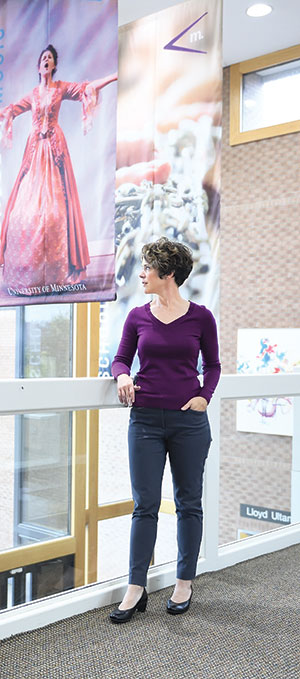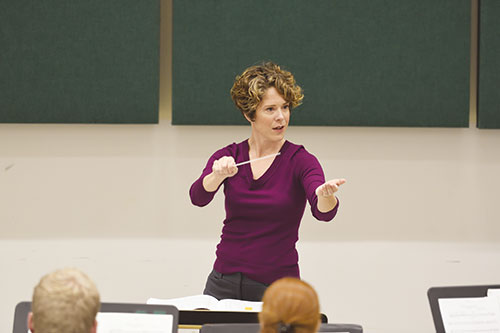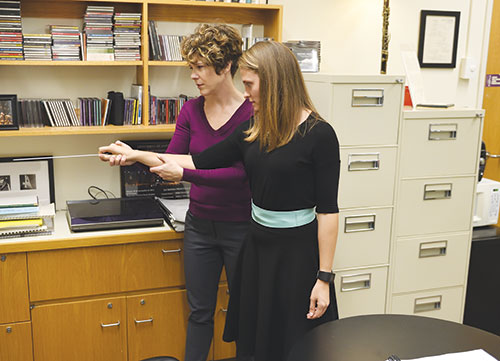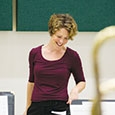Emily Threinen is Director of Bands at the University of Minnesota in Minneapolis, where she conducts the Wind Ensemble, instructs and advises graduate conductors, and teaches undergraduate advanced instrumental conducting. Threinen is continuing the strong legacy left by recent predecessors Frank Bencriscutto and Craig Kirchhoff and building new traditions, including hosting the summer portion of the Minnesota All-State Concert Bands at the University of Minnesota campus in 2018 and 2019.
How did you get started in music?
Music started in my life when I joined choir in elementary school in Illinois. I remember being a soloist on two occasions in my first year, one with the choir and one with piano accompaniment. I do not remember the solo with the choir, but the solo with piano was (Somewhere) Over the Rainbow. I knew then that I loved to perform on stage.
In fifth grade, we were introduced to band instruments, and I wanted to play the saxophone. My music teacher convinced me to play clarinet instead. Ever since I received my school instrument and started playing in a large ensemble, I was hooked. I attended public school in Illinois and Minnesota, and participated in band every year.
At the start of my junior year in high school, I was accepted into the top orchestra of the Minnesota Greater Twin Cities Youth Symphonies. I learned quickly that I needed (and wanted) to be better and could not improve enough on my own. I started taking private clarinet and theory lessons. In my senior year, I auditioned for a couple of university music programs and was admitted as a clarinet performance and music education major to my top choice. In 1994, I started the journey toward becoming a professional musician, pursuing a Bachelor of Music degree at the University of Minnesota School of Music.

How does it feel to serve as Director of Bands at your alma mater?
This is my second year at the University of Minnesota, and I feel a wonderful sense of responsibility to continue the program’s fantastic legacy. Emeritus Director of Bands Craig Kirchhoff was one of my band directors when I was an undergraduate. It is an absolute pleasure to come home and take the baton from Professor Kirchhoff. In so doing, it is important to me to continue the work that has been done, by all former and current directors, while also starting new initiatives and traditions.
What traditions have you started?
There really hasn’t been enough time to label anything we’ve done as a tradition, but I am proud to share our initiatives and current state of affairs. This season, we started a social media presence to get the word out about what we are doing within the comprehensive U of M Band program. In addition to a thriving 320-member marching band, we have six concert bands, including four predominantly non-major bands, which are the largest they have ever been.
In the coming years, we are working toward going on tours and performing at regional and national conferences to build a greater presence in the band community. We are increasing our collaborations with other local ensembles. We are performing joint concerts with community bands and offering events where high school students participate next to college students. We are working to take all groups off campus to perform at high schools and other venues during the daytime. Additionally, we will continue recording projects and collaborations with guest artists and composers.
How involved are you in recruiting?
My opinion is that everyone at a school of music is responsible for recruiting. Every time I work with a high school band, honor band, community, or professional ensemble, there is some level of recruiting. The performers in those ensembles hear what my values are, hear and see how I teach, and feel how I respond to them as musicians. I try to let my work speak for itself and if a prospective student resonates with me, they can find out where I teach.
What common problems do you see when conducting honor bands and giving clinics?
Choosing appropriate repertoire is always the greatest challenge for any guest conductor and clinician. Given that, two of the biggest areas of opportunity nationwide are reading rhythm and internalizing subdivision. Many students struggle with individual ownership of internal pulse, playing music with offbeats, syncopations, and entrances on the and of the beat. It seems that students are less comfortable reading rhythmic notation, as many have shared with me that their teachers sing the rhythms rather than teach how to read. In my experience when pulse and rhythm are secure, addressing artistic elements in the music is easier and more fun.

What lessons did you learn in your first few years of teaching?
A degree in music, at any level, is just the introduction to the work ahead. School can prepare you for many components, but it simply cannot prepare you for everything. My first position was as a public high school band and instrumental music director. I was responsible for all elements of the program. The most important lesson that I learned is that there is much more work to do than there are hours in the day – and the work is constant. Prioritizing is key, but knowing what to prioritize takes time. For your first few years, try to set reasonable goals, address what is most important or necessary first, be proud of what you accomplish, and be patient with yourself in the process.
Additional nuggets of wisdom that I learned in my first years of teaching are to start building the program from the inside out – focus on students and infrastructure; accept that much of your time will be spent on administrative tasks; be incredibly organized; learn to be productive while tired; aim to be positive in all aspects of your work; and stay connected by participating in state, regional, and national events and conferences.
How have you set the tone in your various teaching positions?
In every place I have ever taught I have tried to achieve a high level of organization and excellence. This can start simply with clean and orderly workspaces and clear and timely communication. This sends a message that you care about the learning environment and you are respectful of time. I also believe in creating a culture of leadership and ownership from within an organization – students, parents, colleagues, staff, and others. There are many talented and capable people to learn from and to help.
When I taught high school, I had a band handbook with expectations, rules, assessment, and other details outlined. While teaching in the collegiate setting, I create working documents that all colleagues and graduate students can see and update. We meet on a weekly basis to discuss events, issues, ideas, and updates. I meet with individual colleagues, graduate students, and staff to discuss expectations and needs.
Regarding setting a tone in the classroom, I work to be very clear with my expectations and how we are going to spend our time together. My syllabi have daily details, my rehearsals are organized by the minute, and I communicate what to prepare for our next session as effectively as possible. I also put a daily schedule up on the board. If class starts at 10:00, I’ll say 10:00-10:02 instruments come together, 10:02-10:04 warm up, 10:04-10:06 announcements. When students see a neat room and that level of minute-by-minute organization, that sets an expectation and creates discipline in rehearsals. When I teach, I try to teach with passion, care of those with whom I am working, and commitment to excellence.
What separates good conducting from average conducting?
I believe great conductors are great listeners. They worry more about how the music and ensemble sounds than they do how they move or look. Great conductors are able to adjust how they move to influence what they are hearing from their ensemble.
In the best way possible, all conducting teachers try to get aspiring conductors to connect to the sound and to the musicians in front of them. As a conducting teacher, it is easier to address what is seen because no one is able to hear what another person can hear. Because of this, I tend to ask aspiring conductors many questions, such as: What sounds do you want to hear? Do you want a bright sound, a dark sound? Do you want this section to be wild and crazy or crisp and bright? What is your emotional narrative or your descriptive adjective? Once they have a good descriptor for the emotion or color they want, we discuss the how to move our bodies and hands and use our breath to produce that.
Certainly, all of this takes time. For young conductors, knowing how to listen and what to listen for is a daunting task. I remember my ears when I first began teaching. I could hear the trumpets and upper woodwinds perfectly. Then, I could somewhat hear the bass line. The middle voices were very hard for me to discern. It took several years for me to really be able to hear details of the full ensemble. I have also developed a stronger image of what I want to hear, and my ear goes to the sounds that do not match that image. In the second movement of Lincolnshire Posy, I want to have an even split between horns and reeds. If I start a group and the horns are dominant while everyone else is soft, that guides me to adjust the balance. In the opening of First Suite in Eb, I want a homogenous sound between tubas and euphoniums, but often one of the sections sounds a little louder, especially with younger players. I will notice that right away. That awareness came from several years of standing in front of groups and digging into scores to develop ideas about what I want.
Great conductors also have a strong point of view and impulse of will. They are not afraid to convey their ideas and are willing to get what they want out of the music. This confidence also takes a bit of time and experience.
What advice would you give a new teacher?
All teachers tell their students that the first year is the most difficult. This is true. There will be incredible pressure, frustration, and moments of anxiety. These feelings are a normal part of the experience and the learning curve. Over time these feelings turn into enthusiasm and excitement in a productive way. Be kind to yourself and know that you can bounce back from early difficulties. I also advise new teachers to find mentors who they trust. I am grateful to my own mentors for continued guidance. Finally, keep yourself organized, realize you cannot do everything all of the time, try to keep your enthusiasm for the art burning hot, and do whatever you can to take care of yourself.
Regarding balance, in my experience, early in a career it is very difficult to find balance between work and personal life. The learning curve in our work is steep and knowing where to put energy takes time, especially in new positions. Once a few years are under the belt, the balance can be equalized.
What is the most important lesson you learned from a mentor?
The most important lesson is to remember that we are working with human beings. I love to dig intensely into the music, push an ensemble to a high level of performance, challenge a class on a tough topic, and expect a lot from others, but I do not want to do it without sensitivity. It is important that everyone that I work with feels heard and appreciated.

* * *
Favorite Pieces For High School Band
There are many compositions that would fit this list, but here are my top five high school level band compositions, listed chronologically:
The Florentiner March
Julius Fucˇík (1907)
First Suite in Eb
Gustav Holst (1909)
Irish Tune and Shepherd’s Hey
Percy Grainger (1918)
Courtly Airs and Dances
Ron Nelson (1996)
An American Elegy
Frank Ticheli (2000)





